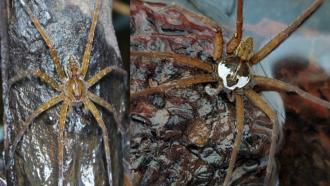![Burmagomphus chaukulensis, aka, Spiny Horntail [Photo: Hemant Ogale] Spiny Horntail – A new dragonfly species discovered in Maharashtra](/sites/researchmatters/files/styles/large_800w_scale/public/photo_hemant_ogale.png?itok=2zHUkjOO)
Burmagomphus chaukulensis, aka, Spiny Horntail [Photo: Hemant Ogale]
A new species of dragonfly discovered in Maharashtra has been named after the village of Chaukul, in the Sindhudurg district of Maharashtra, India, near which it was discovered. The new species, Burmagomphus chaukulensis, aka Spiny Horntail, is now the 3rd known species of Burmagomphus and 84th species of Odonata overall that is endemic to the Western Ghats. The discovery was published in Zootaxa.
The freshwater bodies and accompanying wetlands of the Western Ghats Hotspot are reported to have a high diversity and many instances of endemism of odonates. Odonata is the order of flying insects, which includes the dragonflies and damselflies – that is, odonates - and comprises more than 180 species in the region, which happens to be a UNESCO World Heritage Site.
Hemant Ogale, a mechanical engineer by training and an ardent nature enthusiast, is based in the area, from where he has been identifying and reporting various flora and fauna for over a decade. It was during the 2020 pandemic that he would often take a stroll downstream a brook in a region locally known as ‘Jambhulkond’ to watch dragonflies. Here, the streambed is draped with large green trees and boulders of a purplish-red hue — a sight of beauty. On these lateritic rocks, varieties of dragonflies are commonly encountered.

Habitat of B. chaukulensis at Chaukul [Photo: Hemant Ogale]
On one particular day in June, Ogale came upon a dragonfly he had not seen before. Unable to identify this particular specimen, Ogale photographed it and approached several of his peers, including naturalist Dattaprasad Sawant, a doctor at King Edward Memorial Hospital, Mumbai, who were equally at a loss.
Eventually, Shantanu Joshi and Krushnamegh Kunte from the Biodiversity Lab at the National Centre for Biological Sciences, Bengaluru, got involved in the puzzle. Right away, everyone knew this was possibly an undiscovered species. A month or so of analysis of the body parts of the newly collected specimen, including dissections and observations under the microscope, confirmed that this is indeed a species that has not been reported before.
“In the past 8–9 years, this is the third species that we described from Maharashtra, which is kind of surprising because a majority of the other Indian species discovered before were from the southern western ghats or northeast India, but this shows that there is a lot of hidden diversity in a lot of spaces like even Maharashtra,” says Shantanu Joshi.
So, what was different about this dragonfly from the previously known ones? Well, firstly, the body of the dragonfly had a set of lateral markings that were quite unique – they were black with pale-greenish yellow stripes. Secondly, the shape of the male genitalia was quite obviously different compared to the known species of Burmagomphus.
Lastly, the little hooks on the hamuli were distinctly shaped, unlike any other; hamuli are a part of the secondary male genitalia. These were highly angular and fairly spiny on either side. The common name proposed by the researchers, Spiny Horntail, refers to, in the first part, these spines, while horntail refers to the shape of the tiny outgrowths observed at the end of its tail.
Speaking of the significance of the discovery, Joshi explained how identifying each species in a habitat matters. You need to know about all the species that exist in a place if you are doing a biodiversity inventory, or say, for instance, a monitoring program of freshwater habitats [for which dragonflies are a really favourable organism]. “Now, because we described this species, people know that it exists, and one can plan conservation measures around it,” concludes Joshi.
This article has been run past the researchers, whose work is covered, to ensure accuracy.






